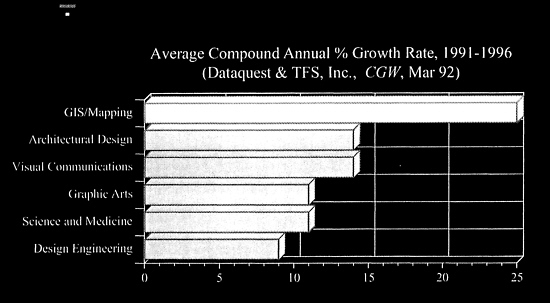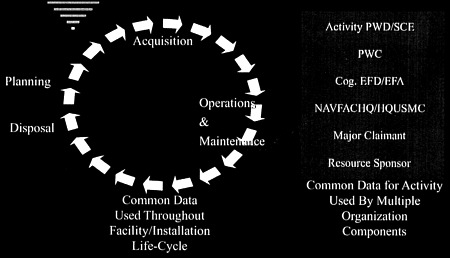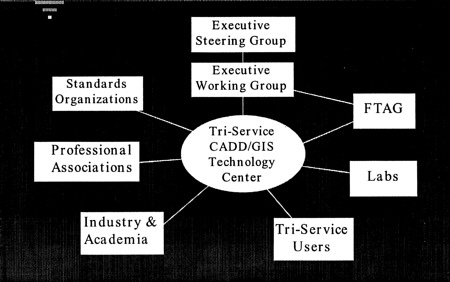WHAT’S AVAILABLE—WHAT FEDERAL PLANNERS WANT: RESULTS OF THE FCC SURVEY
James J. Carberry
Naval Facilities Engineering Command
This is a presentation to relay some highlights of the work of the Federal Construction Council Task Group on the Use of Computer Graphics in Planning. Members of the Task Group are Philip Clark (Air Force), Fred Drummond (Department of Energy), Stewart Grayson (Army), Al Lew (NASA), William Aley (Army Construction Engineering Research Laboratory), Steve Coppedge (Navy), Paul Fardig (Public Health Service), Emil Kish (Department of State), Kent Reed (National Institute of Standards and Technology), and myself. Henry Borger (Federal Construction Council) provided staff support.
The objective of our Task Group was to assemble information on the use of computer graphics systems in planning federal facilities. Early in the study we decided to assemble the desired information in two ways: (1) by conducting a survey of federal agencies, and (2) by sponsoring a symposium on the subject. Originally, our Task Group intended to organize the symposium itself, but when we learned that another FCC group—the Consulting Committee on Comprehensive Planning—was interested in sponsoring a similar symposium, we decided to join forces with them, and today’s symposium is the result of that colaborative effort. My talk today will summarize the results of the Task Group’s survey efforts.
The Task Group actually conducted two surveys of federal agencies. In our first effort we developed a questionnaire aimed at determining what types of computer graphics systems agencies have used for planning and their experiences with those systems. That first survey was not very successful. We received a relatively small response, and many of the experiences described by the respondents related to old systems that are no longer available. The task force concluded that the information would not be very useful to federal agencies contemplating investments in systems today. Accordingly, we conducted a second survey. This time, we surveyed individuals in federal agencies to determine their views on what type of computer graphics system they would recommend that their agency purchase if they were buying one now.
We got a much greater and more enthusiastic response to the second survey—51 individual responses from eight agencies. These were obtained by networking
through the agencies of the members of the Task Group and other agencies represented in the Federal Construction Council. Of course, this is not in any sense a random, stratified sample; we can’t say the results are good to plus or minus three percent as in a Gallup poll. On the other hand (as in the Bayesian approach to statistics), we have some information that we can put to use. This is the distribution of responses by agency:
-
Air Force—41 percent
-
Army—24 percent
-
Navy—12 percent
-
National Institutes of Health—8 percent
-
Public Health Service—4 percent
-
State Department—6 percent
-
National Aeronautics and Space Administration—4 percent
-
Department of Veterans Affairs—2 percent
One of the questions we asked was how the respondent’s knowledge of and views about computer graphics in planning were acquired. Of the 51 respondents, 22 were planners, 15 had supervised planners, 22 had operated planning computer systems, 21 had administered planning computer systems, and 31 had taken courses in the subject. Other sources of knowledge cited were customers, involvement in the implementation of automated mapping/facilities management systems, and literature on the subject.
APPLICATIONS
We asked for the following information about the nature of the planning applications within the respondent’s agency:
-
How installations planning is organized in the agency.
-
The general type of computer graphics system needed.
-
The number of planners who would use the system.
-
Scope of planning activities in the agency.
-
Type of planning activities for which the system would be used
-
Type of personnel who would operate the system
The responses indicate a wide variance in the way planning is organized in the responding agencies, ranging from highly centralized to very decentralized. Almost all of the systems recommended by our respondents involved networks. There was a wide mix of types of planning activities for which the proposed systems were recommended; essentially, it was recommended that the systems be used for all facilities/installations planning activities. Most respondents said that planners should directly operate the system, but wanted at least some specialized computer expertise available to assist the planners.
HARDWARE
Our next major category of questions related to the hardware recommended. We asked the respondents to give their views on general architecture, computing platform, storage devices, input devices, and output devices. Almost all responses recommended networked systems; the few exceptions cited control concerns. I’ll get into details on the computing platforms in a minute. Interestingly, 75 percent of the respondents said that the systems should include CD-ROM storage. Most input and output devices mentioned were fairly conventional (mice, digitizing tablets, color printers and plotters, etc.), but one respondent mentioned a desire to have a video digitizer.
Personal computers were most dominant among the computing platforms recommended. Indeed, for each response in which only one type of computing platform was recommended, it was the personal computer. Most recommended architectures had a mix of platforms, personal computers and engineering workstations were the most typical pairing of platforms (although there were also combinations such as PCs and Mainframes). One response recommended a supercomputer.
Following are the percentages of respondents indicating a preference for various platforms:
-
Personal Computer—82.4 percent
-
X Terminal—9.8 percent
-
Engineering Workstation—64.7 percent
-
Mini Computer—27.5 percent
-
Mainframe Computer—19.6 percent
-
Super Computer—2.0 percent
SOFTWARE
We then asked what type of applications software the respondent recommended for the system, such as Vector Geographic Information Systems (GIS), Raster GIS, other image processing, Computer-Aided Design and Drafting (CADD), space planning and management, technical authoring and electronic publishing, animation, multimedia, hypermedia, planning analysis, simulation, and Data Base Management System (DBMS) software.
The most often specified applications software packages were CADD (92.2 percent) and space planning and management (80.4 percent). Technical publishing software was recommended by 56.9 percent. Hypermedia, animation, multimedia, and other image processing were specified by relatively small percentages. Vector GIS was specified by 64.7 percent, while Raster GIS was specified by only 49 percent.
The relatively lower percentages for GIS software than for CADD indicated here are a little surprising considering the high utility of GIS for planning applications; it may be a matter of insufficient awareness and the longer history of CADD application in planning. This may be changing rather quickly. A projection of the computer graphics market growth by sector performed by Dataquest and TFS, reported in Computer Graphics World, projected that the GIS/Mapping segment would be the fastest growing segment, with 25 percent annual growth over the next several years. The reasons cited (lower cost of systems and greater availability of digital information, high value applications such as environmental impact assessment and environmental cleanup management) apply to federal agencies as well as to the rest of the market. (See Figure 1.)
For facilities/installations planning, the Vector GIS data model has natural applicability to the facilities, but the Raster GIS data model is also useful, especially for resource management and for applications making use of remote sensing data.
OTHER ISSUES
Other questions we asked related to standards, implementation and training, and costs and benefits. Respondents recommending standards mentioned the data structure and processes and procedures as the areas for standardization. Training was frequently mentioned as the most important key to success, and lack of training as the biggest barrier to success.
The most frequently recommended factors to ensure success were training, standards, adequate administration, simplicity and ease of use of the system, keeping the database accurate and up-to-date, and demonstrating the benefits of the system to users and customers. Frequently cited barriers to success were the lack of training and knowledgeable personnel, resistance to change by the personnel involved, limited funding, personnel turnover, lack of management support, the costs of data acquisition and conversion, and conflicts between departments.
The benefits of the respondents’ proposed systems were stated to be improved productivity, quality information (more detailed and accurate) available earlier in the planning process, new information and services available, allowing work to be performed in-house that was formerly contracted out, better responsiveness, improved estimates and better solutions, leveraging large asset values by facility management, and maintaining the organization ’s competitive edge.
It is not surprising that the costs of data acquisition and conversion were cited as barriers to success. For Geographic Information Systems, information costs are generally estimated to be about 70 percent of the life cycle cost of the GIS. Despite the high costs of data, a recent General Accounting Office report found that relatively few federal agencies had a mechanism for coordinating GIS and sharing available data.
Within the Naval facilities community, data sharing is a key issue. The same geographic data is needed not only throughout the facilities ’ life cycle (i.e., data used in planning is also needed for design, construction, operations, maintenance, and
disposal) but is also needed among different organizational elements. For example, map data relating to a Naval activity may be needed not only at the activity Public Works Department (PWD) or the Public Works Center (PWC) serving the activity, but at the cognizant Engineering Field Division (EFD) or Engineering Field Activity (EFA), at Naval Facilities Engineering Command headquarters, and at the Major Claimant and Resource Sponsor offices. Sharing this information in a distributed environment is a major challenge. (See Figure 2.)
NEW DEVELOPMENTS IN DOD
In a “What’s Available” session, I would be remiss to not mention a couple of items becoming available to assist DOD and other federal agencies: the Tri-Service CADD/GIS Technology Center, which support facilities applications in the Department of Defense, and the Facilities CAD2 contract, which will be available to non-DOD federal agencies as well as to DOD components.
The Tri-Service CADD/GIS Technology Center has been established to define central facilities CADD/GIS acquisitions, direct applications development, promote communication and standards, furnish technical advice, interface with professional organizations and industry, evaluate technological developments and recommend necessary CADD/GIS policy. The Center was designed to build on the success of the former U.S. Army Corps of Engineers CADD Center at the Waterways Experiment Station in Vicksburg, MS. In accomplishing its mission, the Center will work with standards organizations such as the National Institute of Standards and Technology, and groups such as the Federal Construction Council. Its work will be accomplished using laboratories throughout the Department of Defense as well as relying on academia and industry. (See Figure 3.)
A key area for the initial focus of the CADD/GIS Technology Center is standards. Within DOD there are multiple CADD/GIS platforms at any one time. What is needed are logical, portable (“vanilla”) data structure standards with implementations on leading platforms. An example of this type of approach can be seen in the Installation/Environmental Overlay effort, where the standards are designed to be implemented on ESRI’s Arc/Info GIS, on Intergraph’s MGE GIS, and on CERL’s GRASS GIS.
The NAVFAC Facilities CAD2 contract is an example of the kind of contracts that the Center will be responsible for in the future. Facilities CAD2 is one of four Navy CAD2 requirements contracts. Its area of focus is facilities applications; the others are for ship design, printing/publishing, and aeronautic and electronics design. The Facilities CAD2 contract represents $500 million out of a total $1.5 billion CAD2 Delegation of Procurement Authority. It specifies an open systems architecture for networked engineering workstations with facilities engineering application software. It is a 12-year contract with 8 years of procurement available, with continuous technology refreshment and price control through a computed price differential requirement for future upgrades to have the same discount as those items originally bid on the contract. The contract will also be available to DOD
agencies besides the Navy and to non-DOD federal agencies. The contract provides access to tools for Computer-Aided Design and Drafting, Geographic Information Systems, and Computer-Aided Facilities Management.
In this sense, the “CAD” in “Facilities CAD2” is a misnomer, in that the contract not only provide GIS, facilities management, electronic publishing, imaging, data management and other software, but also provides an information infrastructure (networking, optical jukeboxes, scanners, etc.) and is an integration tool. GIS (referred to in the contract as “Geoprocessing”) tools include basic mapping, image processing, digital terrain modeling, surveying, cadastral, utilities management, environmental engineering, master planning, and other applications packages. These tools support a paradigm shift wherein a plan is no longer viewed as expressed by a book product but as a dynamic view of selected information in a data base.
[Editor’s Note: Since the March 31 symposium, the Navy has awarded two Facilities CAD2 contracts, with a combined value of up to $550 million. One contract was awarded to Intergraph Corporation; it provides Intergraph workstations, MicroStation CADD software and MGE GIS software. The other contract was awarded to Cordant, Inc.; it provides Sun workstations, AutoCAD CADD software, and Arc/Info GIS software. For information on how to use these contracts, contact Mr. Anthony Joyce or Mr. C.W. Brasfield at (703) 325-0450.]
The FCC Task Force on the Use of Computer Graphics in Planning thanks you for your interest in this subject; the Task Force will be issuing a report on our survey as well as proceedings of this symposium.












